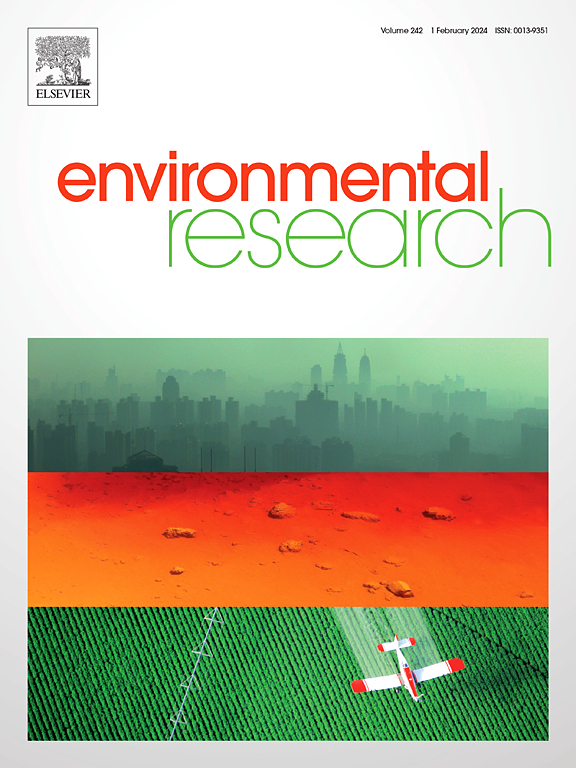十溴聯苯熱分解的機理和動力學:与活性自由基的反应和多溴二苯并呋喃的化学形成
IF 7.7
2区 环境科学与生态学
Q1 ENVIRONMENTAL SCIENCES
引用次数: 0
摘要
尽管作为溴化阻燃剂的多溴联苯(PBBs)的生产和使用已被禁止,但它们仍然对环境和人类健康构成威胁。然而,多溴联苯在废物热处理过程中的演化行为和分解机制仍不清楚。本研究采用量子化学计算方法,详细研究了最常用的多溴联苯同系物之一--十溴联苯(deca-BB)的热分解机理和动力学。结果表明,癸基联苯的键解离能高、能隙大,因此很难发生自分解反应,而它与燃烧环境中的几种活性自由基(包括氢、溴和羟基自由基)的反应则普遍在低能障下进行。氢、溴和羟基自由基对癸-溴原子的对位 C/Br 原子都有很高的选择性,从而产生了多种脱溴产物或中间体。本研究还探讨了癸-溴苯生成多溴二苯并呋喃(PBDF)的机理以及聚合物材料对这一过程的影响。我们发现,原苯基型自由基氧化,然后演化成 PBDFs 的过程是一个非常放热且相对低阻的过程。因此,在形成 PBDF 的过程中,失去正硼原子而产生正苯基型自由基是一个关键步骤。聚合物材料对 PBDF 形成的影响体现在其分解产生的各种烷基自由基和二元自由基很容易抽取正硼原子生成正苯基型自由基,从而促进 PBDF 的形成。本研究提出的机理途径和动力学参数可为控制含十溴联苯废物热处理过程中的污染物排放提供理论指导。本文章由计算机程序翻译,如有差异,请以英文原文为准。
Mechanism and kinetics of thermal decomposition of decabromobiphenyl: Reaction with reactive radicals and formation chemistry of polybrominated dibenzofurans
Although the production and usage of polybrominated biphenyls (PBBs) as brominated flame retardants have already been prohibited, they still pose a threat to the environment and human health. However, the evolutionary behaviors and decomposition mechanisms of PBBs during thermal treatment of waste remain unclear. In the present work, the mechanism and kinetics of thermal decomposition of decabromobiphenyl (deca-BB), one of the most frequently-used PBB congeners, are studied in detail using quantum chemical calculations. Results indicate that the high bond dissociation energies and large energy gap of deca-BB make its self-decomposition reaction difficult to occur, while its reactions with several reactive radicals (including hydrogen, bromine, and hydroxyl radicals) in the combustion environment are universally carried out at low energy barriers. Hydrogen, bromine, and hydroxyl radicals all exhibit a high selectivity for the para-C/Br atoms of deca-BB, resulting in the generation of several debromination products or intermediates. This study also investigates the formation mechanism of polybrominated dibenzofurans (PBDFs) from deca-BB and the effect of polymeric materials on this process. We found that the oxidation of ortho-phenyl-type radical, followed by evolution into PBDFs, is a very exothermic and relatively low-barrier process. Thus, the emergence of ortho-phenyl-type radicals from the loss of ortho-Br atoms is a critical step in the formation of PBDFs. Influence of polymeric materials on the formation of PBDFs is reflected in that various alkyl radicals and diradicals produced by their decomposition can readily abstract ortho-Br atoms to generate ortho-phenyl-type radicals, thus facilitating the formation of PBDFs. The mechanistic pathways and kinetic parameters presented in this study can offer theoretical guidance for controlling contaminant emissions in the thermal treatment of deca-BB-containing waste.
求助全文
通过发布文献求助,成功后即可免费获取论文全文。
去求助
来源期刊

Environmental Research
环境科学-公共卫生、环境卫生与职业卫生
CiteScore
12.60
自引率
8.40%
发文量
2480
审稿时长
4.7 months
期刊介绍:
The Environmental Research journal presents a broad range of interdisciplinary research, focused on addressing worldwide environmental concerns and featuring innovative findings. Our publication strives to explore relevant anthropogenic issues across various environmental sectors, showcasing practical applications in real-life settings.
 求助内容:
求助内容: 应助结果提醒方式:
应助结果提醒方式:


